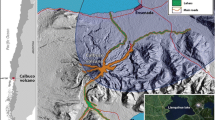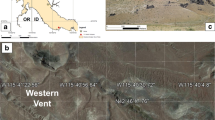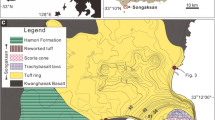Abstract
Phreatomagmatic deposits at Narbona Pass, a mid-Tertiary maar in the Navajo volcanic field (NVF), New Mexico (USA), were characterized in order to reconstruct the evolution and dynamic conditions of the eruption. Our findings shed light on the temporal evolution of the eruption, dominant depositional mechanisms, influence of liquid water on deposit characteristics, geometry and evolution of the vent, efficiency of fragmentation, and the relative importance of magmatic and external volatiles. The basal deposits form a thick (5–20 m), massive lapilli tuff to tuff-breccia deposit. This is overlain by alternating bedded sequences of symmetrical to antidune cross-stratified tuff and lapilli tuff; and diffusely-stratified, clast-supported, reversely-graded lapilli tuffs that pinch and swell laterally. This sequence is interpreted to reflect an initial vent-clearing phase that produced concentrated pyroclastic density currents, followed by a pulsating eruption that produced multiple density currents with varying particle concentrations and flow conditions to yield the well-stratified deposits. Only minor localized soft-sediment deformation was observed, no accretionary lapilli were found, and grain accretion occurs on the lee side of dunes. This suggests that little to no liquid water existed in the density currents during deposition. Juvenile material is dominantly present as blocky fine ash and finely vesiculated fine to coarse lapilli pumice. This indicates that phreatomagmatic fragmentation was predominant, but also that the magma was volatile-rich and vesiculating at the time of eruption. This is the first study to document a significant magmatic volatile component in an NVF maar-diatreme eruption. The top of the phreatomagmatic sequence abruptly contacts the overlying minette lava flows, indicating no gradual drying-out period between the explosive and effusive phases. The lithology of the accidental clasts is consistent throughout the vertical pyroclastic stratigraphy, suggesting that the diatreme eruption did not penetrate below the base of the uppermost country rock unit, a sandstone aquifer ∼360 m thick. By comparison, other NVF diatremes several tens of kilometers away were excavated to depths of ∼1,000 m beneath the paleosurface (e.g., Delaney PT. Ship Rock, New Mexico: the vent of a violent volcanic eruption. In: Beus SS (ed) Geological society of America Centennial Field Guide, Rocky Mountain Section 2:411–415 (1987)). This can be accounted for by structurally controlled variations in aquifer thickness beneath different regions of the volcanic field. Variations in accidental clast composition and bedding style around the edifice are indicative of a laterally migrating or widening vent that encountered lateral variations in subsurface geology. We offer reasonable evidence that this subsurface lithology controlled the availability of external water to the magma, which in turn controlled characteristics of deposits and their distribution around the vent.











Similar content being viewed by others
References
Allen JRL (1982) Sedimentary structures: their character and physical basis. Elsevier, Amsterdam, pp 395–431
Appledorn CR, Wright HE (1957) Volcanic structures in the Chuska Mountains, Navajo Reservation, Arizona–New Mexico. Geol Soc Amer Bull 68:445–468
Barwis JH, Hayes MO (1985) Antidunes on modern and ancient washover fans. J Sed Petrol 55:907–916
Best MG, Christiansen EH (2001) Igneous petrology. Blackwell Science, Malden, MA
Brand BD, White CM (2007) Origin and stratigraphy of phreatomagmatic deposits at the Pleistocene Sinker Butte Volcano, Western Snake River Plain, Idaho. J Volcanol Geotherm Res 160:319–339
Branney MJ, Kokelaar P (1992) A reappraisal of ignimbrite emplacement: progressive aggradation and changes from particulate to non-particulate flow during emplacement of high-grade ignimbrite. Bull Volcanol 54:504–520
Branney MJ, Kokelaar BP (2002) Pyroclastic density currents and the sedimentation of ignimbrites. Geol Soc Lond Mem 27:1–152
Bursik MI, Woods AW (1996) The dynamics and thermodynamics of large ash flows. Bull Volcanol 58:175–193
Büttner R, Dellino P, Zimanowski B (1999) Identifying magma–water interaction from the surface features of ash particles. Nature 401:688–690
Büttner R, Zimanowski B (1998) Physics of thermohydraulic explosions. Phys Rev E 57:5726–5729
Carlson RW, Nowell GM (2001) Olivine-poor sources for mantle-derived magmas: Os and Hf isotopic evidence from potassic magmas of the Colorado Plateau. Geochem Geophys Geosys 2(6). doi:10.1029/2000GC000128
Cather SM (2003) The laramide defiance uplift. In: Lucas SG, Semken SC, Berglof WR, Ulmer-Scholle DS (eds) Geology of the Zuni Plateau: New Mexico. Geol Soc Guidebook 54:6–7
Cather SM, Peters L, Dunbar NW, McIntosh WC (2003) Genetic stratigraphy, provenance, and new age constraints for the Chuska Sandstone (Upper Eocene-Lower Oligocene), New Mexico-Arizona. In: Lucas SG, Semken SC, Berglof WR, Ulmer-Scholle DS (eds) Geology of the Zuni Plateau: New Mexico. Geol Soc Guidebook 54:397–412
Cather SM, Connell SD, Chamberlin RM, McIntosh WC, Jones GE, Potochnik AR, Lucas SG, Johnson PS (2008) The Chuska erg: paleogeomorphic and paleoclimatic implications of an Oligocene sand sea on the Colorado Plateau. Geol Soc Amer Bull 120:13–33
Cas RAF, Wright JV (1987) Volcanic successions: modern and ancient. Alan & Unwin, London, pp 1–528
Chough SK, Sohn YK (1990) Depositional mechanics and sequences of base surges, Songaksan tuff ring, Cheju Island. Sedimentology 37:1115–1135
Cole PD (1991) Migration direction of sand-wave structures in pyroclastic-surge deposits; implications for depositional processes. Geology (Boulder) 19:1108–1111
Cole PD, Guest JE, Duncan AM, Pacheco J-M (2001) Capelinhos 1957–1958, Faial, Azores: deposits formed by an emergent surtseyan eruption. Bull Volcanol 63:204–220
Crowe BM, Fisher RV (1973) Sedimentary structures in base-surge deposits with special reference to cross-bedding, Ubehebe Craters, Death Valley, California. Geol Soc Amer Bull 84:663–682
Delaney PT (1987) Ship Rock, New Mexico: the vent of a violent volcanic eruption. In: Beus SS (ed) Geological society of America Centennial Field Guide, Rocky Mountain Section 2:411–415
Dellino P, Frazzetta G, La Volpe L (1990) Wet surge deposits at La Fossa di Vulcano; depositional and eruptive mechanisms. J Volcanol Geotherm Res 43:215–233
Doubik P, Hill BE (1999) Magmatic and hydromagmatic conduit development during the 1975 Tolbachik eruption, Kamchatka, with implications for hazards assessment at Yucca Mountain, NV. J Volcanol Geotherm Res 91:43–64
Drake TG (1990) Structural features in granular flows. J Geophys Res 95:8681–8696
Druitt TH (1992) Emplacement of the 18 May, 1980 lateral blast deposit east–northeast of Mount St. Helens, Washington. Bull Volcanol 54:554–572
Eaton JG, Nations JD (1991) Introduction: tectonic setting along the margin of the Cretaceous Western Interior Seaway, southwestern Utah and northern Arizona. Geol Soc Am Spec Pap 260:1–8
Ehrenberg SN (1978) Petrology of potassic volcanic rocks and ultramafic xenoliths from the Navajo volcanic field, New Mexico and Arizona. Ph.D. thesis, University of California at Los Angeles
Esperanca S, Holloway JR (1987) On the origin of some mica–lamprophyres; experimental evidence from a mafic minette. Contrib Mineral Petrol 95:207–216
Fisher RV (1966) Mechanism of deposition from pyroclastic flows. Am J Sci 264:350–363
Fisher RV (1979) Models for pyroclastic surges and pyroclastic flows. J Volcanol Geotherm Res 6:305–318
Fisher RV, Schmincke H-U (1984) Pyroclastic rocks. Springer, Berlin
Fisher R, Schmincke H (1994) Volcaniclastic sediment transport and deposition. Blackwell Scientific, Edinburgh
Fisher R, Waters AC (1970) Base surge bed forms in Maar volcanoes. Am Journ Sci 268:157–180
Freundt A, Bursik MI (2001) Pyroclastic flow and transport mechanisms. In: Freundt A, Rosi M (eds) From magma to tephra. Elsevier, Amsterdam, pp 25–51
Godchaux MM, Bonnichsen B, Jenks MD (1992) Types of phreatomagmatic volcanoes in the western Snake River Plain, Idaho, USA. J Volcanol Geotherm Res 52:1–25
Gonzales D, Burgess RT, Critchley MR, Turner BE (2006) New perspectives on the emplacement mechanisms involved in diatreme formation in the northeastern Navajo volcanic field, southwestern Colorado. Geol Soc Am Abstracts with Programs 38:4
Hanes DM, Bowen AJ (1985) A granular-fluid model for steady intense bed-load transport. J Geophys Res 90:9149–9158
Hein FJ (1982) Depositional mechanism of deep sea coarse clastic sediments, Cap Enrage Formation, Quebec. Can J Earth Sci 19:276–287
Heiken GH (1971) Tuff rings; examples from the Fort Rock-Christmas Lake valley basin, south-central Oregon. J Geophys Res 76:5615–5626
Houghton BF, Hackett WR (1984) Strombolian and phreatomagmatic deposits of Ohakune Craters, Ruapehu, New Zealand; a complex interaction between external water and rising basaltic magma. J Volcanol Geotherm Res 21:207–231
Houghton BF, Schmincke HU (1986) Mixed deposits of simultaneous strombolian and phreatomagmatic volcanism; Rothenberg Volcano, East Eifel volcanic field. J Volcanol Geotherm Res 30:117–130
Houghton BF, Wilson CJN (1989) A vesicularity index for pyroclastic deposits. Bull Volcanol 51:451–462
Houghton BF, Wilson CJN, Smith IEM (1999) Shallow-seated controls on styles of explosive basaltic volcanism; a case study from New Zealand. J Volcanol Geotherm Res 91:97–120
Humphreys E, Hessler E, Dueker K, Farmer GL, Erslev E, Atwater T (2003) How Laramide-age hydration of North American lithosphere by the Farallon Slab controlled subsequent activity in the Western United States. Inter Geol Rev 45:575–595
Jopling AV, Richardson EV (1966) Backset bedding developed in shooting flow in laboratory experiments. J Sed Petrol 36:821–825
Kneller BC, Branney MJ (1995) Sustained high-density turbidity currents and the deposition of thick massive sands. Sedimentology 42:607–616
Kokelaar P (1983) The mechanism of Surtseyan volcanism. J Geol Soc Lond 140:939–944
Kokelaar P (1986) Magma–water interactions in subaqueous and emergent basaltic volcanism. Bull Volcanol 48:275–289
Lin JT, Pao YH (1979) Wakes in stratified fluids. Ann Rev Fluid Mech 11:317–338
Lorenz V (1974) Vesiculated tuffs and associated features. Sedimentology 21:273–291
Lorenz V (1982) The 1977 explosive eruptions of the Ukinrek Maars, Alaska. Terra Cogn 2:205–206
Lorenz V (1986) On the growth of maars and diatremes and its relevance to the formation of tuff rings. Bull Volcanol 48:265–274
Lorenz V, Haneke J (2004) Relationship between diatremes, dykes, sills, laccoliths, intrusive-extrusive domes, lava flows, and tephra deposits with unconsolidated water-saturated sediments in the late Variscan intermontane Saar-Nahe Basin, SW Germany. Geol Soc Am Spec Pub 234:75–124
Lorenz V, Kurszlaukis S (2007) Root zone processes in the phreatomagmatic pipe emplacement model and consequences for the evolution of maar-diatreme volcanoes. J Volcanol Geotherm Res 159:4–32
Lowe D (1976) Subaqueous liquefied and fluidized sediment flows and their deposits. Sedimentology 23:285–308
Lowe D (1982) Sediment gravity flows II: depositional models with special reference to the deposits of high-density turbidity currents. J Sed Petrol 52:279–297
Lucas SG, Cather SM (2003) Stratigraphy of the Paleogene Chuska Sandstone, New Mexico-Arizona. In: Lucas SG, Semken SC, Berglof WR, Ulmer-Scholle DS (eds) Geology of the Zuni Plateau: New Mexico. Geol Soc Guidebook 54:397–412
Lucas SG, Semken SC, Heckert AB, Berglof WR, Hoffman G, Kues BS, Crumpler LS, Aubele JC (2003) First-day road log. In: Lucas SG, Semken SC, Berglof WR, Ulmer-Scholle DS (eds) Geology of the Zuni Plateau: New Mexico Geol Soc Guidebook 54:1–34
Mastin LG (1991) The roles of magma and groundwater in the phreatic eruptions at Inyo Craters, Long Valley Caldera, California. Bull Volcanol 53:579–596
Mastin LG (2007) The Generation of fine hydromagmatic ash by growth and disintegration of glassy rinds. J Geophys Res 112:1–17
Mastin LG, Christiansen RL, Thornber C, Lowenstern J, Beeson M (2004) What makes hydromagmatic eruptions violent? Some insights from the Keanakako'i Ash, Kilauea Volcano, Hawai'i. J Volcanol Geotherm Res 137:15–31
McFadden LD, McDonald EV, Wells SG, Anderson JQ, Forman SL (1998) The vesicular layer and carbonate collars of desert soils and pavements: formation, age and relation to climate change. Geomorphology 24:101–145
Middleton GV (1965) Antidune cross-bedding in a large flume. J Sed Petrol 35:922–927
Nemeth K, White JDL (2003) Reconstructing eruption processes of a Miocene monogenetic volcanic field from vent remnants; Waipiata volcanic field, South Island, New Zealand. J Volcanol Geotherm Res 124:1–21
Nemeth K, Matrin U, Harangi Sz (2001) Miocene Phreatomagmatic volcanism at Tihany (Pannonian Basin, Hungary). J Volcanol Geotherm Res 111:111–135
Paola C, Wiele SM, Reinhart MA (1989) Upper-regime parallel lamination as the result of turbulent sediment transport and low-amplitude bed forms. Sedimentology 36:47–59
Postma G (1986) Classification for sediment gravity-flow deposits based on flow conditions during sedimentation. Geology (Boulder) 14:291–294
Roden MF (1981) Origin of coexisting minette and ultramafic breccia, Navajo volcanic field. Cont Min Petrol 77:195–206
Rosi M (1992) A model for the formation of vesiculated tuff by the coalescence of accretionary lapilli. Bull Volcanol 54:429–434
Schmidt K-H (1991) Tertiary palaeoclimatic history of the southeastern Colorado Plateau. Palaeogeogr Palaeoclimatol Palaeoecol 86:283–296
Schmincke H-U, Fisher RV, Waters A (1973) Antidune and chute and pool structures in the base surge deposits of the Laacher See area, Germany. Sedimentology 20:553–574
Self S, Kienle J, Huot JP (1980) Ukinrek Maars, Alaska, II: deposits and formation of the 1977 craters. J Volcanol Geotherm Res 7:39–65
Semken S (2003) Black rocks protruding up: the Navajo volcanic field. In: Lucas SG, Semken SC, Berglof WR, Ulmer-Scholle DS (eds) Geology of the Zuni Plateau: New Mexico. Geol Soc Guidebook 54:397–412
Shaanan U, Weinberger R, Navon O (2007) The relation between volatile-rich magma and phreatomagmatism: an example from Birket Ram, the Northern Golan. International Union of Geodesy and Geophysics Meeting XXIV, IAVCEI Scientific Program VS018:10
Sheridan MF, Wohletz KH (1983) Hydrovolcanism: Basic Considerations and Review. J Volcanol Geotherm Res 17:1–29
Smith D, Levy S (1976) Petrology of the Green Knobs diatreme and implications for the upper mantle below the Colorado Plateau. Earth Planet Sci Lett 29:107–125
Smith D, Connelly JN, Manser K, Moser DE, Housh TB, McDowell FW, Mack LE (2004) Evolution of Navajo eclogites and hydration of the mantle wedge below the Colorado Plateau, Southwestern United States. Geochem Geophys Geosyst 5:Q04005 DOI 10.1029/2003GC000675
Sohn YK (1997) On traction-carpet sedimentation. J Sed Res 67:502–509
Sohn YK, Chough SK (1989) Depositional processes of the Suwolbong tuff ring, Cheju Island (Korea). Sedimentology 36:837–855
Sparks RSJ (1976) Grain size variations in ignimbrites and implications for the transport of pyroclastic flows. Sedimentology 23:147–188
Sparks RSJ, Wilson L, Hulme G (1978) Theoretical modeling of the generation, movement, and emplacement of pyroclastic flows by column collapse. J Geophys Res 83:1727–1739
Stone WJ, Lyford FP, Frenzel PF, Mizell NH, Padgett ET (1983) Hydrogeology and water resources of San Juan Basin, New Mexico. Hydrologic Report, New Mexico Bureau of Mines and Mineral Resources 6:70
Trevena AS, Nash WP (1979) Chemistry and provenance of detrital plagioclase. Geology (Boulder) 7:475–478
U.S. Geological Survey map (1992) Narbona Pass, New Mexico. 1:24,000, 7.5 Minute Series. Washington DC
Valentine GA (1987) Stratified flow in pyroclastic surges. Bull Volcanol 49:616–630
Valentine GA, Giannetti B (1995) Single pyroclastic beds deposited by simultaneous fallout and surge processes; Roccamonfina Volcano, Italy. J Volcanol Geotherm Res 64:129–137
Valentine GA, Groves KR (1996) Entrainment of country rock during basaltic eruptions of the Lucero volcanic field, New Mexico. J Geol 104:71–90
Waters AC, Fisher RV (1971) Base surges and their deposits; Capelinhos and Taal volcanoes. J Geophys Res 76:5596–5614
White JDL (1996) Pre-emergent construction of a lacustrine basaltic volcano, Pahvant Butte, Utah (USA). Bull Volcanol 58:249–262
White JDL (2001) Eruption and reshaping of Pahvant Butte Volcano in Pleistocene Lake Bonneville. Spec Pub Int Assoc Sed 30:61–80
Wilson L, Sparks RSJ, Huang TC, Watkins ND (1978) The control of volcanic column heights by eruption energetics and dynamics. J Geophys Res 83:1829–1836
Wohletz KH, McQueen RG (1984) Experimental studies of hydromagmatic volcanism. Studies of geophysics. National Academy, Washington, DC, pp 158–169
Wohletz KH, Sheridan MF (1979) Model of pyroclastic surge. Geol Soc Am Spec Pap 180:177–194
Wright HE (1956) Origin of the Chuska sandstone, Arizona–New Mexico; a structural and petrographic study of a Tertiary eolian sediment. Geol Soc Amer Bull 67:413–434
Zimanowski B (1986) Fragmentations prozesse beim explosiven Vulkanismus in der Westeifel. Dr rer nat Thesis, Joh Gutenberg-Universität Mainz
Zimanowski B, Buettner R (2003) Phreatomagmatic explosions in subaqueous volcanism. Geophys Monograph 140:51–60
Zimanowski B, Fröhlich G, Lorenz V (1991) Quantitative experiments on phreatomagmatic explosions. J Volcanol Geotherm Res 48:341–358
Acknowledgments
We thank the Navajo Nation Minerals Department for permission to conduct field research at Narbona Pass. Anyone who wishes to conduct field investigations on the Navajo Nation must first apply for and receive a permit from the Navajo Nation Minerals Department in Window Rock, Navajo Nation, Arizona. We are especially grateful for the assistance of Cassandra Namingha in the field during summer 2005, and the steady support of Doris Bahee. Funding for this research was provided by a Geological Society of America Student Research Grant, an Arizona NASA Space Grant Consortium Student Fellowship, and the National Science Foundation, USA (EAR 0538125). The Division of Mathematics, Science, and Technology at Diné College, directed by Marnie Carroll, provided funding for C. Namingha’s participation. This paper greatly benefited from thorough, thoughtful, and insightful reviews by Greg Valentine, Larry Mastin, and from the associate editor James White. Ahéhee’ to all!
Author information
Authors and Affiliations
Corresponding author
Additional information
Editorial responsibility: J. White
Electronic supplementary material
Below is the link to the electronic supplementary material.
Rights and permissions
About this article
Cite this article
Brand, B.D., Clarke, A.B. & Semken, S. Eruptive conditions and depositional processes of Narbona Pass Maar volcano, Navajo volcanic field, Navajo Nation, New Mexico (USA). Bull Volcanol 71, 49–77 (2009). https://doi.org/10.1007/s00445-008-0209-y
Received:
Accepted:
Published:
Issue Date:
DOI: https://doi.org/10.1007/s00445-008-0209-y




